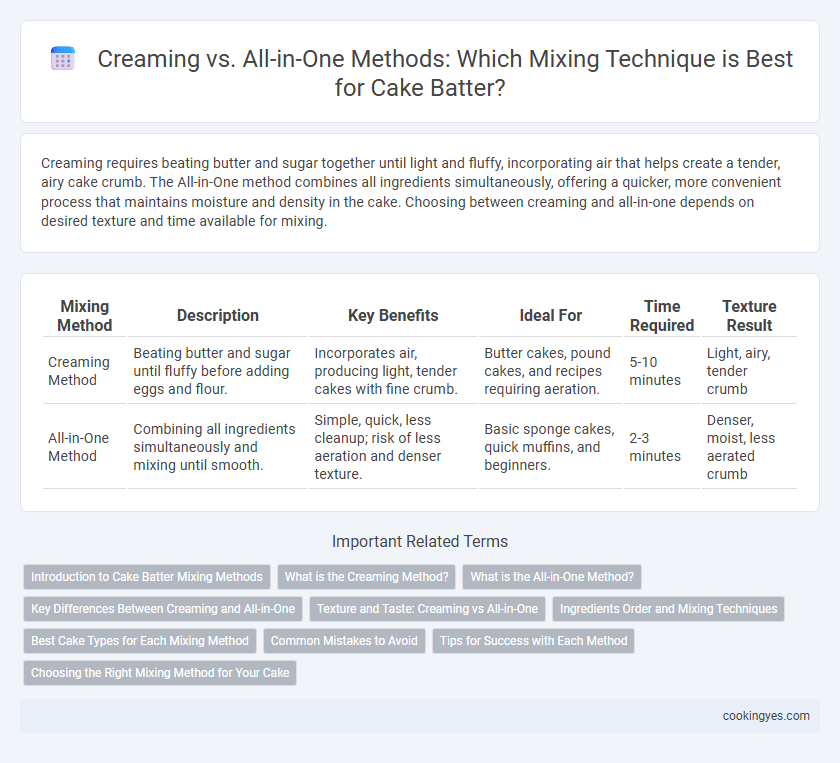Creaming requires beating butter and sugar together until light and fluffy, incorporating air that helps create a tender, airy cake crumb. The All-in-One method combines all ingredients simultaneously, offering a quicker, more convenient process that maintains moisture and density in the cake. Choosing between creaming and all-in-one depends on desired texture and time available for mixing.
Table of Comparison
| Mixing Method | Description | Key Benefits | Ideal For | Time Required | Texture Result |
|---|---|---|---|---|---|
| Creaming Method | Beating butter and sugar until fluffy before adding eggs and flour. | Incorporates air, producing light, tender cakes with fine crumb. | Butter cakes, pound cakes, and recipes requiring aeration. | 5-10 minutes | Light, airy, tender crumb |
| All-in-One Method | Combining all ingredients simultaneously and mixing until smooth. | Simple, quick, less cleanup; risk of less aeration and denser texture. | Basic sponge cakes, quick muffins, and beginners. | 2-3 minutes | Denser, moist, less aerated crumb |
Introduction to Cake Batter Mixing Methods
Creaming and all-in-one are two fundamental cake batter mixing methods that significantly influence texture and crumb structure. Creaming involves beating butter and sugar until light and fluffy, creating air pockets for a tender, airy cake, while all-in-one combines all ingredients simultaneously, simplifying preparation and producing a denser, moist crumb. Understanding these methods helps bakers tailor cakes to desired softness, rise, and crumb consistency.
What is the Creaming Method?
The creaming method involves beating sugar and fat, typically butter, together until light and fluffy, incorporating air to create a tender cake crumb. This technique ensures even distribution of fat and sugar, promoting better structure and rise during baking. Proper creaming results in a smooth batter that produces a fine, delicate texture in the finished cake.
What is the All-in-One Method?
The All-in-One method combines all ingredients--flour, sugar, butter, eggs, and liquids--into a single bowl for faster and simpler mixing of cake batter. This technique efficiently disperses fat and incorporates air to produce a tender crumb without separate creaming steps. Ideal for moist cakes, it reduces preparation time while maintaining consistent texture and rise.
Key Differences Between Creaming and All-in-One
Creaming involves beating butter and sugar together until light and fluffy, incorporating air that helps create a tender crumb, while the All-in-One method combines all ingredients simultaneously, saving time but producing a denser texture. The creaming method allows better control over ingredient incorporation and aeration, ideal for cakes requiring a delicate rise, whereas All-in-One is favored for simplicity and speed in recipes like sponge cakes. Understanding these key differences helps bakers choose the appropriate technique based on desired cake texture and preparation time.
Texture and Taste: Creaming vs All-in-One
Creaming method involves beating butter and sugar together, creating a light and airy texture that results in a cake with a tender crumb and rich flavor. The all-in-one method mixes all ingredients simultaneously, producing a denser cake with a moister interior but less pronounced airiness. Texture-wise, creaming yields fluffier cakes, while the all-in-one approach offers convenience with a slightly denser bite and uniformly moist taste.
Ingredients Order and Mixing Techniques
Creaming involves beating butter and sugar first to incorporate air, creating a light and fluffy texture, while the all-in-one method combines all ingredients simultaneously for quicker preparation but less aeration. The order of ingredients in creaming is crucial: start with softened butter and sugar, then add eggs gradually before folding in dry and liquid components. Mixing techniques in creaming require careful beating to develop structure, whereas all-in-one relies on thorough blending to ensure even distribution without overmixing.
Best Cake Types for Each Mixing Method
Creaming method suits butter cakes like pound cakes and layer cakes, producing a light, tender crumb by incorporating air through beating butter and sugar. All-in-one method works best for sponge cakes and quick cakes, streamlining mixing by combining all ingredients simultaneously for a faster, consistent batter. Selecting the right method depends on desired texture and cake type, optimizing moisture and rise.
Common Mistakes to Avoid
Overmixing during the creaming method can lead to dense, tough cakes by over-developing gluten, while undermixing results in uneven texture or pockets of flour. In the all-in-one method, failing to properly combine dry and wet ingredients before mixing often causes lumpy batters and inconsistent rise. Avoid using cold ingredients in both methods to ensure proper emulsification and aeration, critical for light and fluffy cake structure.
Tips for Success with Each Method
For creaming, ensure butter is softened to room temperature and beat it with sugar until light and fluffy to incorporate air for a tender crumb. When using the all-in-one method, mix dry and wet ingredients gently to avoid overworking gluten, which can result in a dense cake. Always use accurate ingredient measurements and avoid overmixing regardless of the method to achieve consistent cake texture and rise.
Choosing the Right Mixing Method for Your Cake
Choosing the right cake batter mixing method significantly impacts texture and flavor--creaming incorporates butter and sugar until light and fluffy, creating a tender, airy crumb ideal for butter cakes. The all-in-one method combines all ingredients simultaneously, offering speed and simplicity, best suited for denser cakes and sponge varieties. Understanding the differences helps bakers optimize moisture retention, crumb structure, and rise for desired cake outcomes.
Creaming vs All-in-One for cake batter mixing Infographic

 cookingyes.com
cookingyes.com